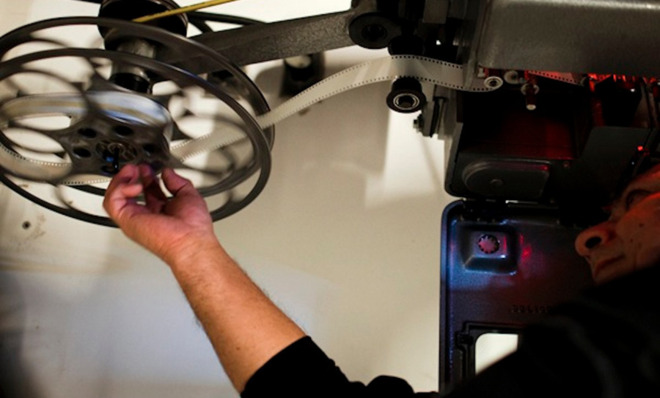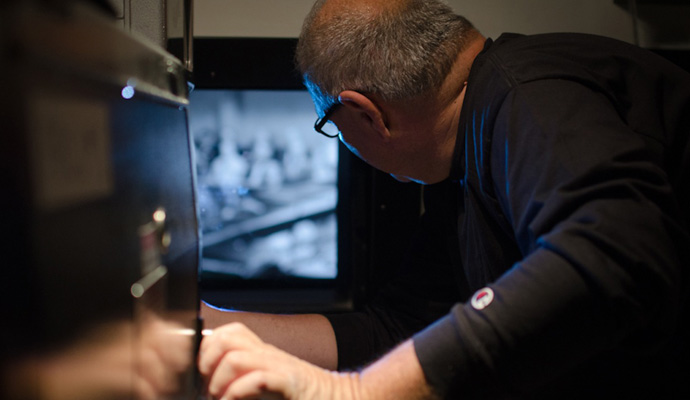The curator of nostalgia
One of New York's last reel-to-reel movie men adapts to life in a digital age


Back in the days when most films were beamed onto screens from rolling projection reels, Richard Aidala absolutely hated going to the movies. After the lights went down, he found himself unable to pay attention to the plot, and could barely stand to look at the images in front of him. All he saw were mistakes. What was that reflection on the screen? Wasn't the focus off? And what was going on with those lamps? The lamps needed to be realigned!
"I complained so much that nobody in my family would go to the cinema with me," he says now, exploding into a characteristic burst of rowdy laughter.
But Aidala, a graying 62-year-old with bushy eyebrows, a sharp nose, and a perpetual grin, is no cinema buff. In fact, he has absolutely no interest in the craft of filmmaking. All he cares about is how films are shown.
The Week
Escape your echo chamber. Get the facts behind the news, plus analysis from multiple perspectives.

Sign up for The Week's Free Newsletters
From our morning news briefing to a weekly Good News Newsletter, get the best of The Week delivered directly to your inbox.
From our morning news briefing to a weekly Good News Newsletter, get the best of The Week delivered directly to your inbox.
Professionally, Aidala has done one thing for forty years: show moving images in theaters. Before cinemas switched to digital projectors, before films could fit on a hard drive, before most of his peers lost their jobs, he worked the reels in dark rooms, perched high above New York City's movie-going public.
(More from Narratively: The view from the top of the social ladder)
Aidala, who first started working in theaters at the age of twenty, is now the chief projectionist at the Museum of the Moving Image in Queens, where he gratifies a never-ending stream of cinephiles, or "Cinemaniacs," as a 2003 documentary about film buffs christened them.
In the world of film, where writers, directors, cinematographers, and, of course, actors, are placed on a pedestal, the public has long overlooked the importance of the projectionist — the single person who, at least at one time, had absolute control over your viewing experience. But the lack of recognition — the anonymity offered by this post — is just fine with Aidala, who, despite an imposing physical presence, is most comfortable slipping into the background.
A free daily email with the biggest news stories of the day – and the best features from TheWeek.com
"A good projectionist should be invisible," he says, his small rectangular glasses steadied on his forehead. "No one should be able to tell you're in the booth changing the reels."
Today, no one does. The reels have become obsolete, and, increasingly, so has the projectionist. Aidala still has a job because he's lucky enough to work at a museum of cinema, one of the few places in the country where his knowledge remains relevant.
He's the master of a dying art, a curator of nostalgia.
* * *

In the 1940s and '50s, the heyday of reel-to-reel cinema, Local 306, New York City's projectionist union, was 3,500-people strong. Now one of the last single-trade unions in the country, it barely registers a hundred members.
"We're dinosaurs," Aidala says, looking over his shoulder at one of his colleagues, Hunter Webb, on a recent Saturday afternoon at the museum.
The dimly lit projection room where the two men work contrasts with the immaculate lobby of the Museum of the Moving Image, a hall surrounded by large windowpanes and bathed in daylight. Instead of posters, images from on-site exhibitions are projected onto the white walls of the museum, whose futuristic design makes clear that it celebrates both old movies and film innovation. As such, it is one of the only places where digital and reel-to-reel projectors still cohabitate.
(More from Narratively: One crazy night in an Upper East Side mansion)
On weekends, the museum has multiple screenings simultaneously and needs four projectionists on hand. But on weekdays, there's only enough work for one of them.
Aidala has manned the museum's projection booth since it opened 24 years ago. As the longest-serving projectionist at one of the country's most venerable film-preservation institutions, he is widely regarded as among the most knowledgeable in his field.
On this day, though, he isn't running the show. Webb, standing nearby, is operating the projector for today's retrospective. The 42-year-old gets busy behind the reels, his long, dark hair gathered in a messy ponytail so it doesn't get in the way. As Webb runs a print of Michelangelo Antonioni's short film "L'Amorosa Menzogna," Aidala eats a lunch of fries and a hamburger, seated among dozens of film prints stacked in metal cases. The heavy canisters are meant to protect celluloid film and keep it away from too much light, though prints occasionally arrive at the museum damaged or even shredded.
Today's screening is a complicated one, Aidala explains, as it includes a dozen Antonioni shorts spanning the prolific Italian filmmaker's half-century career. Each is in a different format, reflecting the evolution of the industry and its standards since Antonioni began his eclectic career in 1942. Some of his shorts are on VHS tape, others on DVD, and others, still, on 35-millimeter prints.
After running the print of "L'Amorosa," Webb abandons the projector to operate a VCR, then starts spooling film on a reel, preparing for the next showing.

Since about 1895, movies were printed on five-foot-wide reels of 35-millimetre film, then laced onto the rolling spools of a projector. Now, they're computer files that don't need rolling to be beamed onto a screen.
When Aidala's at the movies himself — which happens only rarely, since he, ironically enough, prefers TV — he can relax and get immersed in the clean, digital experience; his impulse to watch out for defects lies dormant.
Professionally, however, the transition from film has left many projectionists like Aidala out of work. Increasingly, the job requires nothing more than plugging in a hard drive. Though he regrets that many of his former colleagues have been rendered obsolete, Aidala surprisingly does not lament the old days; he unabashedly dismisses those who say vintage reels are better than flawless digital copies.
(More from Narratively: Instruments made from trash)
"I prefer digital, definitely," Aidala admits, sitting at his desk overlooking the museum's 250-seat theater on a recent weekday afternoon. "Digital is 99.9 percent as good as pristine 35-millimeter print." The intimate experience of screening a crisp print is undeniable, he says, but digital screenings are so hands-off that there's less margin for error.
One early spring weekend, the museum screens a 24-hour static shot of the Wilshire Federal Building in Los Angeles, a piece by conceptual artist Mary Ellen Carroll — "a crazy woman," Aidala says, rolling his eyes. The film, unlike many others that Aidala shows at the museum, is digital. He chooses the lighting, makes sure the shot isn't out of frame, and then waits. And waits. He's there only to make sure nothing goes wrong. It's a long, empty, workday.
Read the rest of this story at Narratively.
Narratively is an online magazine devoted to original, in-depth and untold stories. Each week, Narratively explores a different theme and publishes just one story a day. It was one of TIME's 50 Best Websites of 2013.
-
 ‘The menu’s other highlights smack of the surreal’
‘The menu’s other highlights smack of the surreal’Instant Opinion Opinion, comment and editorials of the day
-
 Education: More Americans say college isn’t worth it
Education: More Americans say college isn’t worth itfeature College is costly and job prospects are vanishing
-
 One great cookbook: ‘More Than Cake’
One great cookbook: ‘More Than Cake’the week recommends The power of pastry brought to inspired life